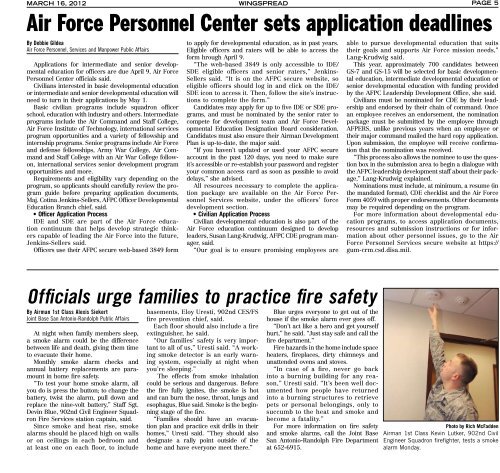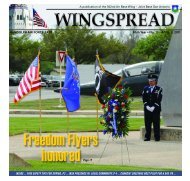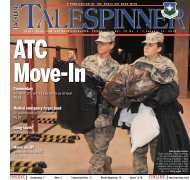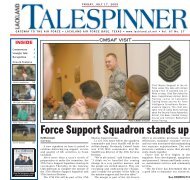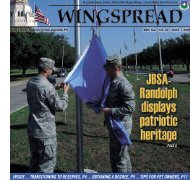JBSA- Randolph Chapel - San Antonio News
JBSA- Randolph Chapel - San Antonio News
JBSA- Randolph Chapel - San Antonio News
Create successful ePaper yourself
Turn your PDF publications into a flip-book with our unique Google optimized e-Paper software.
MARCH 16, 2012 WINGSPREAD<br />
PAGE 5<br />
Air Force Personnel Center sets application deadlines<br />
By Debbie Gildea<br />
Air Force Personnel, Services and Manpower Public Affairs<br />
Applications for intermediate and senior developmental<br />
education for officers are due April 9, Air Force<br />
Personnel Center officials said.<br />
Civilians interested in basic developmental education<br />
or intermediate and senior developmental education will<br />
need to turn in their applications by May 1.<br />
Basic civilian programs include squadron officer<br />
school, education with industry and others. Intermediate<br />
programs include the Air Command and Staff College,<br />
Air Force Institute of Technology, international services<br />
program opportunities and a variety of fellowship and<br />
internship programs. Senior programs include Air Force<br />
and defense fellowships, Army War College, Air Command<br />
and Staff College with an Air War College followon,<br />
international services senior development program<br />
opportunities and more.<br />
Requirements and eligibility vary depending on the<br />
program, so applicants should carefully review the program<br />
guide before preparing application documents,<br />
Maj. Cotina Jenkins-Sellers, AFPC Officer Developmental<br />
Education Branch chief, said.<br />
• Officer Application Process<br />
IDE and SDE are part of the Air Force education<br />
continuum that helps develop strategic thinkers<br />
capable of leading the Air Force into the future,<br />
Jenkins-Sellers said.<br />
Officers use their AFPC secure web-based 3849 form<br />
to apply for developmental education, as in past years.<br />
Eligible officers and raters will be able to access the<br />
form hrough April 9.<br />
“The web-based 3849 is only accessible to IDE/<br />
SDE eligible officers and senior raters,” Jenkins-<br />
Sellers said. “It is on the AFPC secure website, so<br />
eligible officers should log in and click on the IDE/<br />
SDE icon to access it. Then, follow the site’s instructions<br />
to complete the form.”<br />
Candidates may apply for up to five IDE or SDE programs,<br />
and must be nominated by the senior rater to<br />
compete for development team and Air Force Developmental<br />
Education Designation Board consideration.<br />
Candidates must also ensure their Airman Development<br />
Plan is up-to-date, the major said.<br />
“If you haven’t updated or used your AFPC secure<br />
account in the past 120 days, you need to make sure<br />
it’s accessible or re-establish your password and register<br />
your common access card as soon as possible to avoid<br />
delays,” she advised.<br />
All resources necessary to complete the application<br />
package are available on the Air Force Personnel<br />
Services website, under the officers’ force<br />
development section.<br />
• Civilian Application Process<br />
Civilian developmental education is also part of the<br />
Air Force education continuum designed to develop<br />
leaders, Susan Lang-Krudwig, AFPC CDE program manager,<br />
said.<br />
“Our goal is to ensure promising employees are<br />
able to pursue developmental education that suits<br />
their goals and supports Air Force mission needs,”<br />
Lang-Krudwig said.<br />
This year, approximately 700 candidates between<br />
GS-7 and GS-15 will be selected for basic developmental<br />
education, intermediate developmental education or<br />
senior developmental education with funding provided<br />
by the AFPC Leadership Development Office, she said.<br />
Civilians must be nominated for CDE by their leadership<br />
and endorsed by their chain of command. Once<br />
an employee receives an endorsement, the nomination<br />
package must be submitted by the employee through<br />
AFPERS, unlike previous years when an employee or<br />
their major command mailed the hard copy application.<br />
Upon submission, the employee will receive confirmation<br />
that the nomination was received.<br />
“This process also allows the nominee to use the question<br />
box in the submission area to begin a dialogue with<br />
the AFPC leadership development staff about their package,”<br />
Lang-Krudwig explained.<br />
Nominations must include, at minimum, a resume (in<br />
the mandated format), CDE checklist and the Air Force<br />
Form 4059 with proper endorsements. Other documents<br />
may be required depending on the program.<br />
For more information about developmental education<br />
programs, to access application documents,<br />
resources and submission instructions or for information<br />
about other personnel issues, go to the Air<br />
Force Personnel Services secure website at https://<br />
gum-crm.csd.disa.mil.<br />
Officials urge families to practice fire safety<br />
By Airman 1st Class Alexis Siekert<br />
Joint Base <strong>San</strong> <strong>Antonio</strong>-<strong>Randolph</strong> Public Affairs<br />
At night when family members sleep,<br />
a smoke alarm could be the difference<br />
between life and death, giving them time<br />
to evacuate their home.<br />
Monthly smoke alarm checks and<br />
annual battery replacements are paramount<br />
in home fire safety.<br />
“To test your home smoke alarm, all<br />
you do is press the button; to change the<br />
battery, twist the alarm, pull down and<br />
replace the nine-volt battery,” Staff Sgt.<br />
Devin Blue, 902nd Civil Engineer Squadron<br />
Fire Services station captain, said.<br />
Since smoke and heat rise, smoke<br />
alarms should be placed high on walls<br />
or on ceilings in each bedroom and<br />
at least one on each floor, to include<br />
basements, Eloy Uresti, 902nd CES/FS<br />
fire prevention chief, said.<br />
Each floor should also include a fire<br />
extinguisher, he said.<br />
“Our families’ safety is very important<br />
to all of us,” Uresti said. “A working<br />
smoke detector is an early warning<br />
system, especially at night when<br />
you’re sleeping.”<br />
The effects from smoke inhalation<br />
could be serious and dangerous. Before<br />
the fire fully ignites, the smoke is hot<br />
and can burn the nose, throat, lungs and<br />
esophagus, Blue said. Smoke is the beginning<br />
stage of the fire.<br />
“Families should have an evacuation<br />
plan and practice exit drills in their<br />
homes,” Uresti said. “They should also<br />
designate a rally point outside of the<br />
home and have everyone meet there.”<br />
Blue urges everyone to get out of the<br />
house if the smoke alarm ever goes off.<br />
“Don’t act like a hero and get yourself<br />
hurt,” he said. “Just stay safe and call the<br />
fire department.”<br />
Fire hazards in the home include space<br />
heaters, fireplaces, dirty chimneys and<br />
unattended ovens and stoves.<br />
“In case of a fire, never go back<br />
into a burning building for any reason,”<br />
Uresti said. “It’s been well documented<br />
how people have returned<br />
into a burning structures to retrieve<br />
pets or personal belongings, only to<br />
succumb to the heat and smoke and<br />
become a fatality.”<br />
For more information on fire safety<br />
and smoke alarms, call the Joint Base<br />
<strong>San</strong> <strong>Antonio</strong>-<strong>Randolph</strong> Fire Department<br />
at 652-6915.<br />
Photo by Rich McFadden<br />
Airman 1st Class Kevin Lutker, 902nd Civil<br />
Engineer Squadron firefighter, tests a smoke<br />
alarm Monday.


